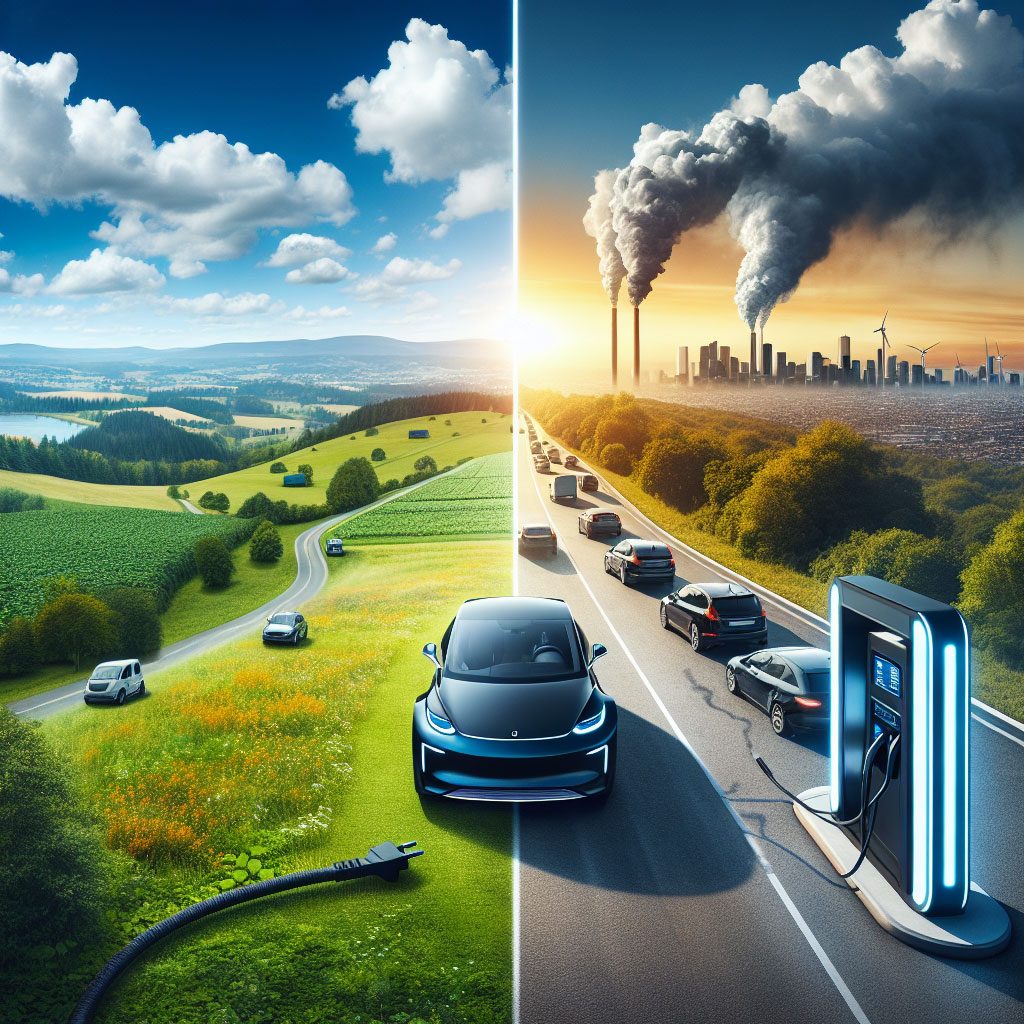
Electric vehicles (EVs) are often promoted as the cleaner option. Yet on social media and in some corners of the internet you’ll find confident claims that EVs are worse for the planet because of energy-intensive battery production and difficult-to-extract materials. That debate has real consequences for public opinion, policy and consumer choice in Australia – so it’s worth cutting through the noise and looking at the evidence.
The short answer from the best available science and industry analysis: manufacturing an EV generally produces more CO2 than building an equivalent internal combustion engine (ICE) car. But over the life of the vehicle – once you factor in lower operational emissions, and especially if the electricity used to charge the vehicle is low-emissions – the balance swings decisively in favour of EVs. This conclusion is consistent across multiple independent studies and modelled scenarios around the world.
Understanding lifecycle emissions
When experts compare EVs and ICE vehicles they look at lifecycle greenhouse gas emissions: that is, emissions from extracting and processing raw materials, vehicle and battery manufacture, the use phase (fuel or electricity consumed during driving), and end-of-life treatment (recycling, disposal and potential second-life use of batteries). Key drivers of the comparison are:
- The carbon intensity of battery and vehicle manufacturing (including mining and refining of materials such as lithium, cobalt and nickel).
- The source of electricity used to charge EVs (coal, gas, renewables).
- The total distance driven over the vehicle’s life.
- Improvements in manufacturing efficiency and grid decarbonisation over time.
What leading studies say
CSIRO (Australia)
Our national science agency notes that while battery manufacturing and EV production have clear environmental impacts, numerous studies show EVs have a significantly lower lifetime carbon footprint than combustion-engine cars – particularly when they are charged from renewable electricity.
BloombergNEF (BNEF)
BNEF produced a detailed 2020 analysis comparing lifecycle CO2 of battery electric vehicles (BEVs) and ICE cars, modelling vehicles driven 250,000 km and manufactured in five countries (UK, Germany, France, US and China). Their findings: EV production emits more CO2 up front than an equivalent petrol vehicle, but the “payback” in avoided tailpipe emissions occurs quickly. In the US example they modelled, a BEV requires roughly 27,000 km to achieve a lifecycle CO2 advantage.
International Energy Agency (IEA)
The IEA offers an interactive calculator that lets users vary assumptions about vehicle types and electricity mixes. Even under conservative scenarios – for example where 90% of EV charging electricity is coal-sourced – the IEA’s modelling in many cases still favours EVs over petrol equivalents. In Australia today, with around 40% of the grid supplied by renewables (and jurisdictions such as the ACT and Tasmania effectively at 100%), the charging emissions picture is already attractive for EV owners.
US Environmental Protection Agency (EPA)
The EPA addresses common myths and finds that greenhouse gas emissions associated with an EV over its lifetime are typically lower than for the average gasoline vehicle, even when accounting for manufacturing emissions.
European Environmental Agency (EEA)
In a 2018 life cycle assessment review the EEA concluded the majority of LCAs show BEVs have lower life cycle greenhouse gas emissions than ICE vehicles. They estimated that raw material and production stages for BEVs are typically 1.3-2 times more CO2 intensive than for ICEVs, but this is usually offset by lower per-kilometre emissions in the use phase depending on electricity source.
International Council on Clean Transportation (ICCT)
The ICCT’s 2021 lifecycle assessment compared regions including Europe, the US, China and India, and modelled future scenarios to 2030. It found that BEVs already have the lowest life-cycle greenhouse gas emissions, and the advantage is forecast to increase as electricity grids and manufacturing decarbonise.
Automaker analyses: Polestar and Tesla
Some manufacturers now publish their own life cycle assessments. Polestar’s recent LCA for the Polestar 3 found material production and refining accounted for 38% of the vehicle’s climate impact, with the vehicle use phase contributing about 37%, and battery modules about 16%. Tesla’s annual impact reports perform region-specific modelling (for example New York, France and China) and emphasise that as grids add more renewable energy, the emissions advantage of EVs grows.
What this means for Australia
- Upfront emissions: Building an EV typically emits more CO2 than building an ICE car because of battery production and the mining of battery materials.
- Payback over time: That initial carbon “debt” is usually repaid through lower emissions while driving – the distance to payback depends on your local grid mix and how much you drive, but available analyses suggest it can be reached within tens of thousands of kilometres rather than hundreds of thousands.
- Grid decarbonisation helps fast-track benefits: The more renewables on the grid, the faster an EV delivers lifecycle emissions savings. Australia’s increasing share of renewables (around 40% nationally and higher in some states and territories) already improves the environmental case for EVs, and further decarbonisation will widen the advantage.
- Other pollutant reductions: Beyond CO2, EVs eliminate tailpipe emissions of NOx, particulates and other harmful pollutants – important public health benefits in urban areas.
Addressing common concerns
- Mining and materials: Mining for lithium, cobalt and nickel raises social and environmental concerns. Cleaner mining practices, stronger regulation, and the development of lower- or zero-cobalt chemistries will help. Recycling and second-life battery applications are also critical to reduce demand for raw materials.
- Battery recycling and second life: Improvements in battery recycling can recover valuable metals and reduce lifecycle impacts. Second-life applications (stationary storage) can extend the useful life of batteries before recycling.
- Manufacturing improvements: Automakers and suppliers are improving efficiency and cutting emissions in battery and vehicle production. Lifecycle assessments will evolve as manufacturing decarbonises.
Practical tips for Australian consumers
- If reducing carbon footprint matters, an EV charged from a cleaner grid is usually the better choice over the vehicle lifetime.
- Consider smaller, more efficient models; lighter vehicles generally have lower lifecycle emissions.
- Charge during times of high renewable electricity supply where possible (some retailers offer time-of-use plans that encourage this).
- Choose manufacturers with transparent lifecycle reporting and solid recycling or battery take-back programs.
- Buying a used EV can be an especially effective way to lower per-kilometre emissions, since the manufacturing emissions have already been borne.
Conclusion
The preponderance of evidence from reputable science agencies, independent research organisations and manufacturers is clear: while producing an EV – largely because of batteries and mining – typically results in higher upfront CO2 emissions than producing a similar petrol car, that initial deficit is generally repaid during the vehicle’s lifetime through lower operational emissions. The advantage becomes more pronounced as electricity grids decarbonise and as improvements in mining, production and recycling reduce the manufacturing footprint. For Australia, with its growing share of renewable energy, the lifecycle case for EVs is only strengthening. EVs also bring the additional public health benefits of zero tailpipe pollution in urban areas, reinforcing their environmental value beyond CO2 alone.
FAQs
Q: Are EVs worse for the environment because of battery production?
A: No. Battery and vehicle manufacturing do produce more CO2 upfront than producing a comparable ICE vehicle, but lifecycle analyses consistently show that EVs typically produce fewer greenhouse emissions over their operational life – particularly when charged from low-emissions electricity.
Q: How long does it take for an EV to “pay back” its manufacturing emissions?
A: Estimates vary by study and region, but examples such as BloombergNEF’s modelling suggest payback can occur within tens of thousands of kilometres (about 27,000 km in one US case). The exact distance depends on the carbon intensity of the electricity used for charging and how much the vehicle is driven.
Q: What about mining impacts for lithium, cobalt and nickel?
A: Mining has environmental and social impacts that must be managed. Advances in mining standards, the development of lower-cobalt battery chemistries, improved recycling, and second-life battery uses can reduce demand for newly mined materials and lower lifecycle impacts.
Q: Will EVs get even cleaner in the future?
A: Yes. As grids incorporate more renewables and manufacturers reduce emissions in production – and as recycling and battery chemistry improvements progress – the lifecycle advantage of EVs over ICE vehicles is projected to increase.
Q: Is buying a used EV better for the environment?
A: Often yes. Buying used means the manufacturing emissions are already “sunk,” so the remaining operational emissions are the main consideration. Provided the battery health is adequate, a used EV can be one of the most carbon-efficient transport choices.
About EV Evolution
EV Evolution is the leading online platform dedicated to Australian electric vehicle owners and enthusiasts. We foster a vibrant community, delivering essential EV news and insights, and enhancing user engagement through our innovative, AI-powered chatbot for dynamic discussions. Our mission is to empower Australian electric vehicle owners and enthusiasts by fostering a vibrant, AI-driven online community that connects, informs, and advances the nation’s electric vehicle landscape.




